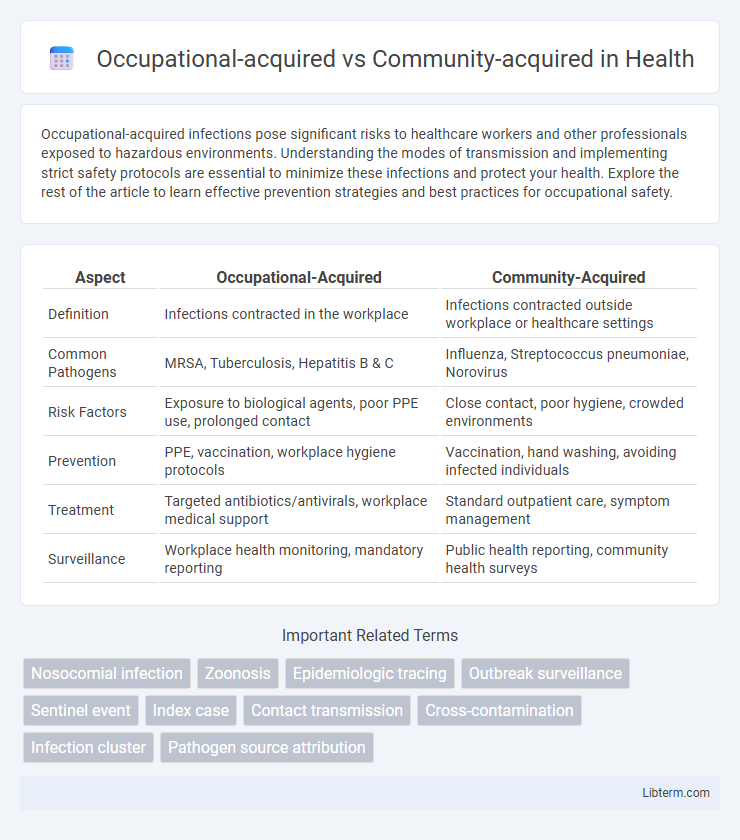Occupational-acquired infections pose significant risks to healthcare workers and other professionals exposed to hazardous environments. Understanding the modes of transmission and implementing strict safety protocols are essential to minimize these infections and protect your health. Explore the rest of the article to learn effective prevention strategies and best practices for occupational safety.
Table of Comparison
| Aspect | Occupational-Acquired | Community-Acquired |
|---|---|---|
| Definition | Infections contracted in the workplace | Infections contracted outside workplace or healthcare settings |
| Common Pathogens | MRSA, Tuberculosis, Hepatitis B & C | Influenza, Streptococcus pneumoniae, Norovirus |
| Risk Factors | Exposure to biological agents, poor PPE use, prolonged contact | Close contact, poor hygiene, crowded environments |
| Prevention | PPE, vaccination, workplace hygiene protocols | Vaccination, hand washing, avoiding infected individuals |
| Treatment | Targeted antibiotics/antivirals, workplace medical support | Standard outpatient care, symptom management |
| Surveillance | Workplace health monitoring, mandatory reporting | Public health reporting, community health surveys |
Introduction to Occupational-acquired and Community-acquired Infections
Occupational-acquired infections refer to infections contracted in the workplace due to exposure to biological hazards such as bacteria, viruses, or fungi, commonly affecting healthcare workers, laboratory personnel, and agricultural workers. Community-acquired infections occur outside healthcare settings and are typically transmitted through person-to-person contact, contaminated surfaces, or environmental sources, often resulting in illnesses like influenza, pneumonia, or streptococcal infections. Understanding the distinct pathways and risk factors of occupational-acquired versus community-acquired infections is crucial for implementing targeted infection control measures and reducing disease transmission.
Defining Occupational-acquired Infections
Occupational-acquired infections are infections contracted primarily due to exposure in the workplace environment, often affecting healthcare workers, laboratory personnel, or individuals in high-risk industries such as agriculture and construction. These infections result from direct contact with infectious agents, contaminated materials, or biohazards encountered during job-related activities. Understanding the specific pathogens, transmission routes, and preventive measures within occupational settings is crucial for controlling and reducing the incidence of occupational-acquired infections.
Understanding Community-acquired Infections
Community-acquired infections (CAIs) are infections contracted outside healthcare settings, typically involving common pathogens such as Streptococcus pneumoniae, Haemophilus influenzae, and influenza viruses. These infections often affect the respiratory tract, urinary tract, and skin, with transmission occurring through person-to-person contact, respiratory droplets, or environmental exposure. Understanding community-acquired infections involves recognizing their epidemiology, antimicrobial resistance patterns, and the impact of public health measures like vaccination and hygiene practices on infection control.
Key Differences Between Occupational and Community Acquisition
Occupational-acquired infections typically occur in workplace environments where individuals are exposed to hazards such as healthcare settings, construction sites, or laboratories, often involving direct contact with biological agents or toxic substances. Community-acquired infections arise outside professional settings, affecting the general population through everyday interactions, commonly involving respiratory pathogens, foodborne bacteria, or environmental exposures. Key differences include the source of exposure, the types of pathogens involved, and preventive measures tailored specifically to workplace safety protocols versus public health strategies.
Common Pathogens Involved
Occupational-acquired infections often involve pathogens such as Staphylococcus aureus, including MRSA, Pseudomonas aeruginosa, and Legionella pneumophila, which are prevalent in healthcare and industrial settings. Community-acquired infections commonly feature Streptococcus pneumoniae, Haemophilus influenzae, and community strains of Escherichia coli as primary pathogens causing respiratory and urinary tract infections. Understanding the distinct microbial profiles aids in targeted antimicrobial therapy and infection control strategies.
Risk Factors in Occupational Settings
Occupational-acquired infections typically arise from direct exposure to biological agents, hazardous chemicals, or contaminated equipment in workplace settings such as healthcare, agriculture, and manufacturing sectors. Key risk factors include inadequate personal protective equipment (PPE), poor ventilation, frequent close contact with infected individuals or materials, and insufficient occupational safety training. Community-acquired infections, in contrast, are influenced primarily by environmental exposure, hygiene practices, and social behaviors outside the workplace.
Risk Factors in Community Settings
Community-acquired infections primarily stem from exposure to pathogens in public spaces, with risk factors including close contact with infected individuals, poor hygiene practices, and crowded living conditions. Environmental elements such as contaminated water, inadequate sanitation, and limited access to healthcare also elevate susceptibility. Behavioral factors like smoking, underlying chronic diseases, and age extremes further contribute to the risk of community-acquired infections.
Prevention and Control Strategies
Prevention and control strategies for occupational-acquired infections emphasize strict adherence to workplace safety protocols, including the use of personal protective equipment (PPE), routine training, and regular health screenings to minimize exposure to infectious agents. Community-acquired infection control relies heavily on public health measures such as vaccination campaigns, hygiene promotion, early diagnosis, and isolation of contagious individuals to prevent widespread transmission. Targeted surveillance and tailored intervention programs based on the specific infection source significantly enhance the effectiveness of containment efforts in both occupational and community settings.
Diagnosis and Treatment Approaches
Diagnosis of occupational-acquired infections often requires detailed workplace exposure history and targeted testing for specific pathogens prevalent in industrial or healthcare settings, while community-acquired infections rely on broader clinical assessments and common diagnostic panels. Treatment approaches for occupational-acquired infections may include specialized antimicrobial regimens tailored to resistant strains encountered in occupational environments, alongside workplace decontamination protocols. Community-acquired infections generally follow standard empirical therapy guidelines based on regional antibiotic resistance patterns and patient history.
Conclusion: Importance of Source Identification
Accurate identification of occupational-acquired versus community-acquired infections is critical for targeted intervention strategies and effective resource allocation. Source identification enables healthcare professionals to implement specific preventive measures, reducing transmission within workplaces or the community. Understanding the origin of infection also informs public health policies, improving outbreak control and minimizing economic and health impacts.
Occupational-acquired Infographic

 libterm.com
libterm.com